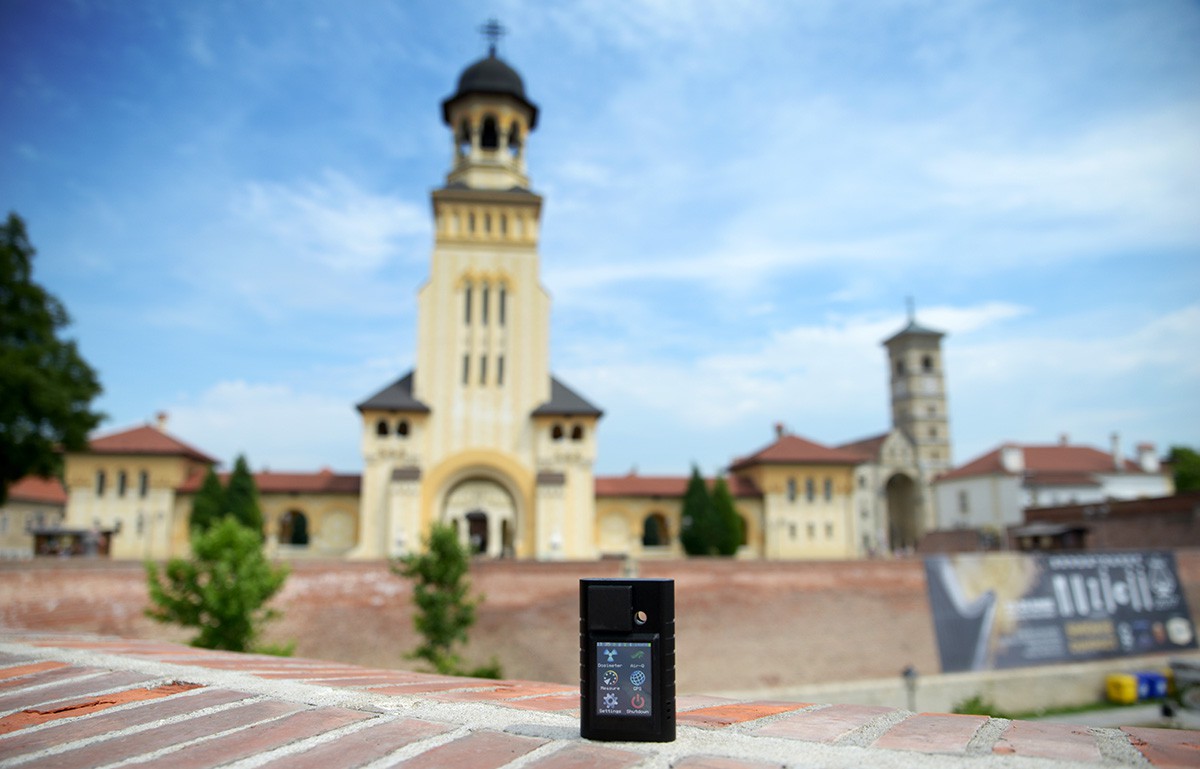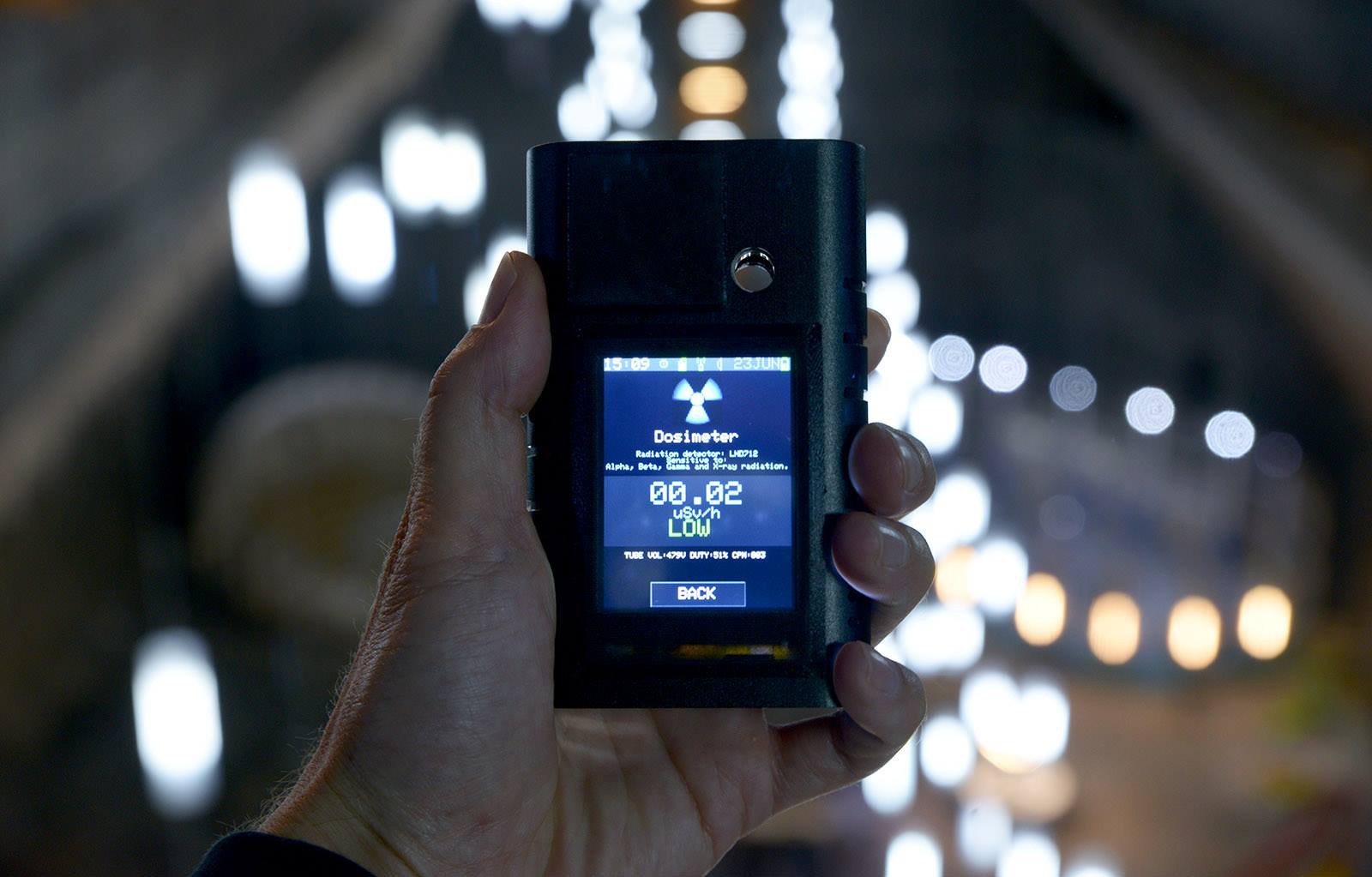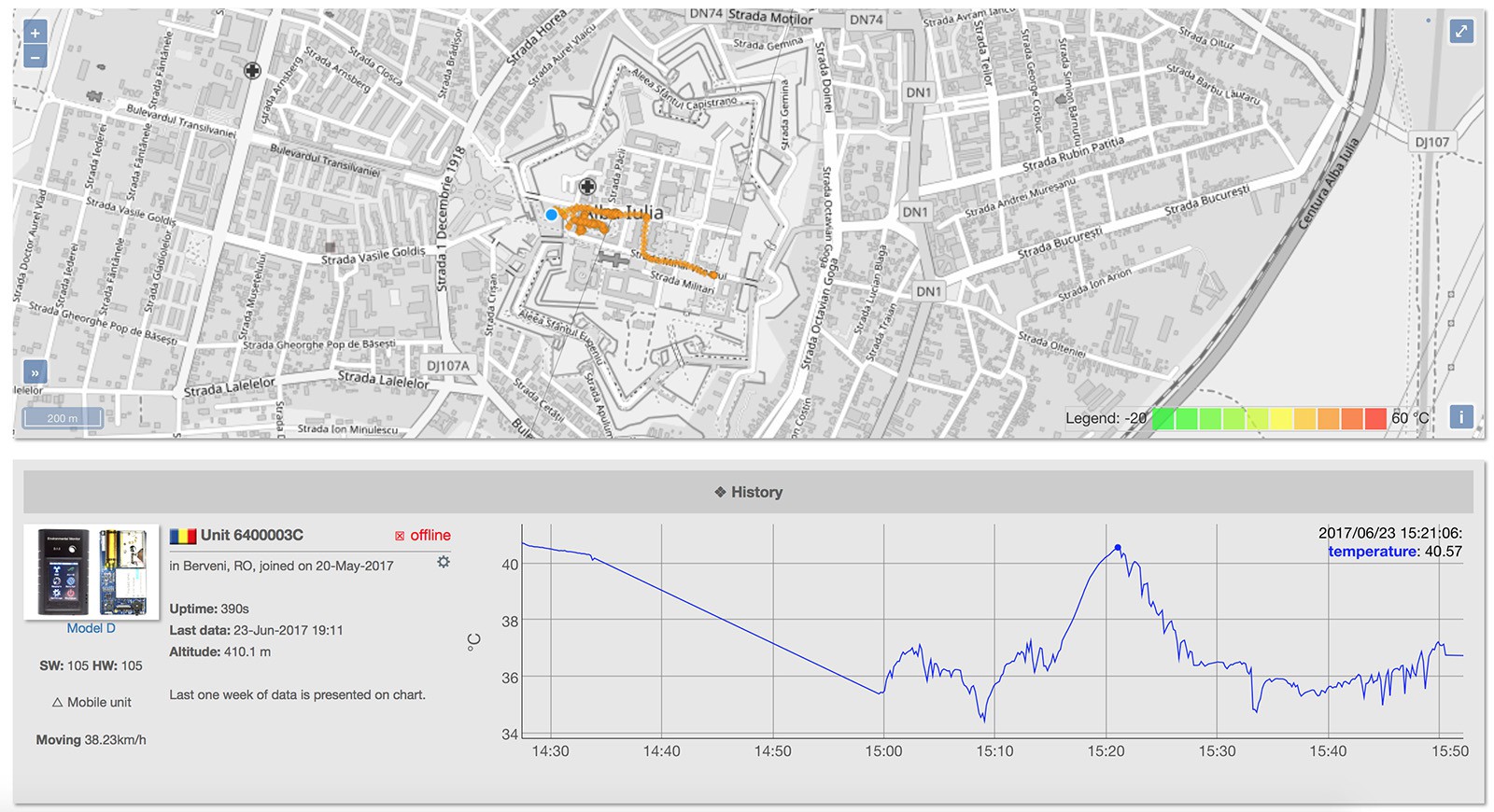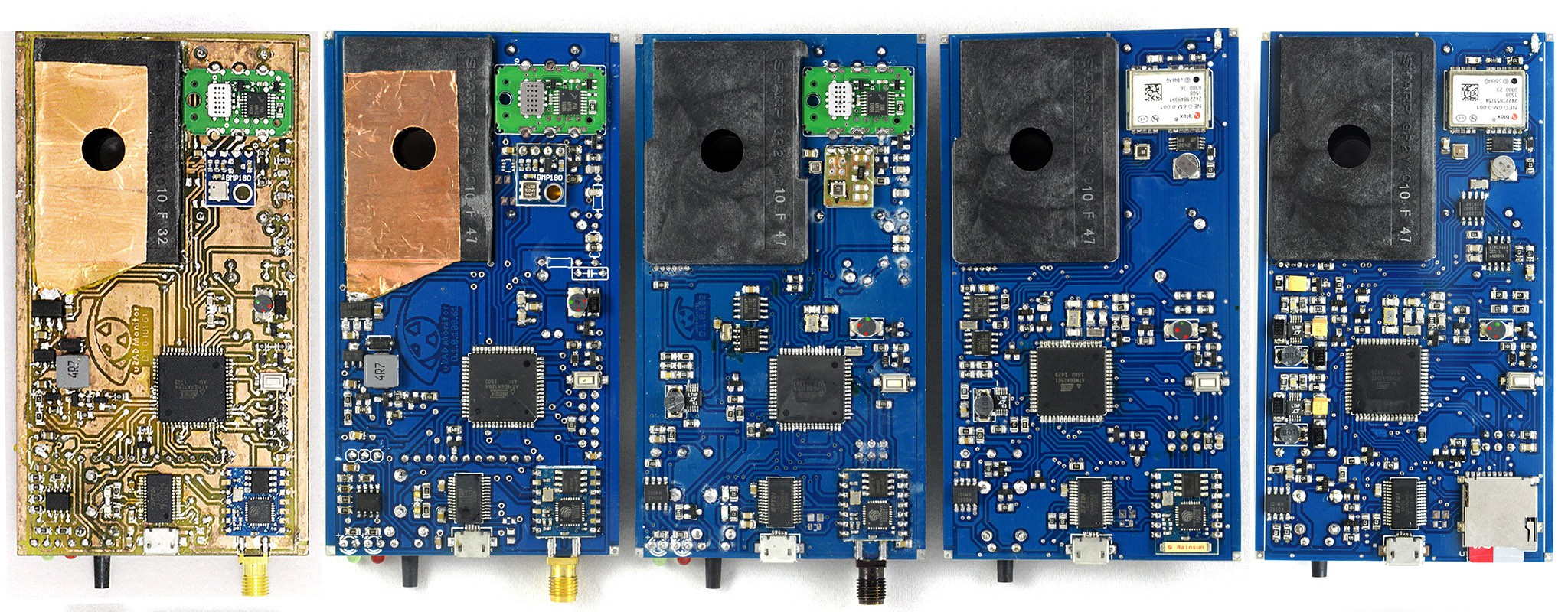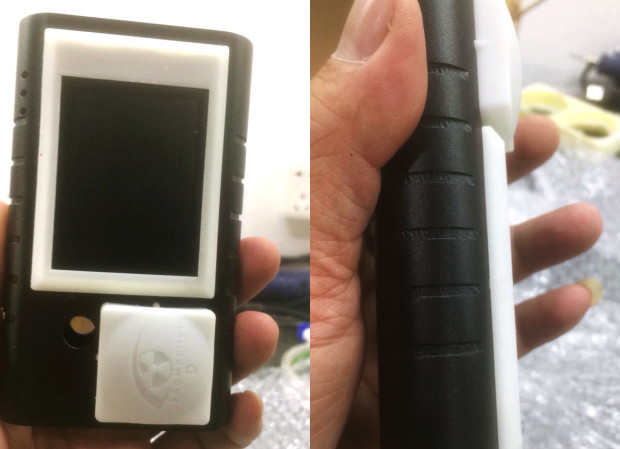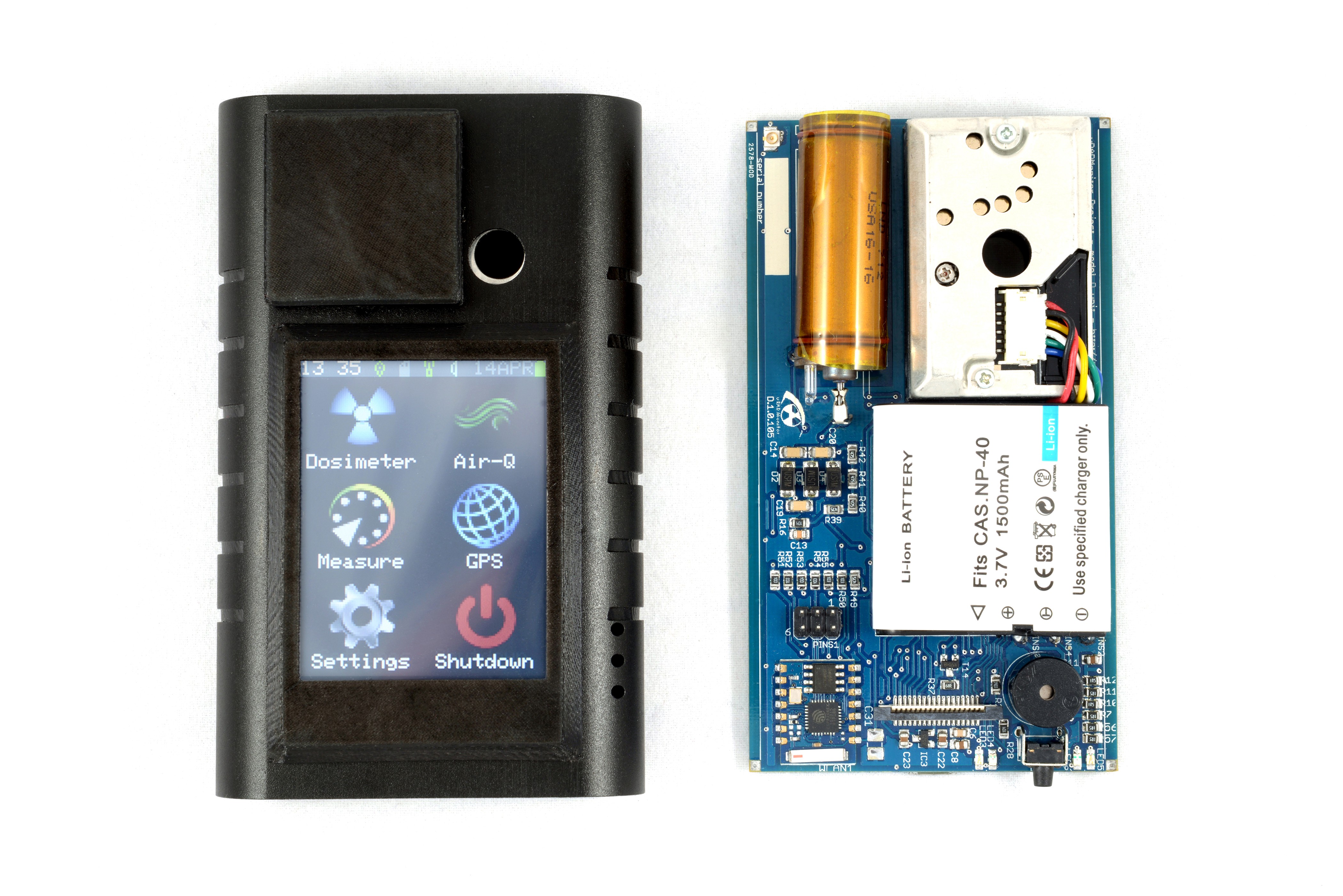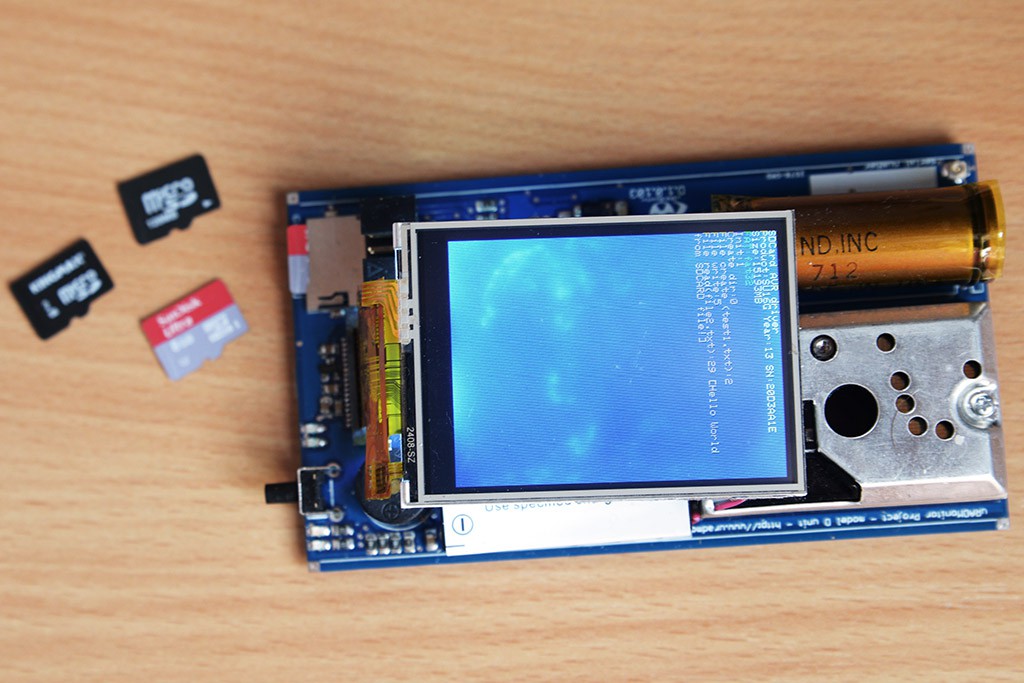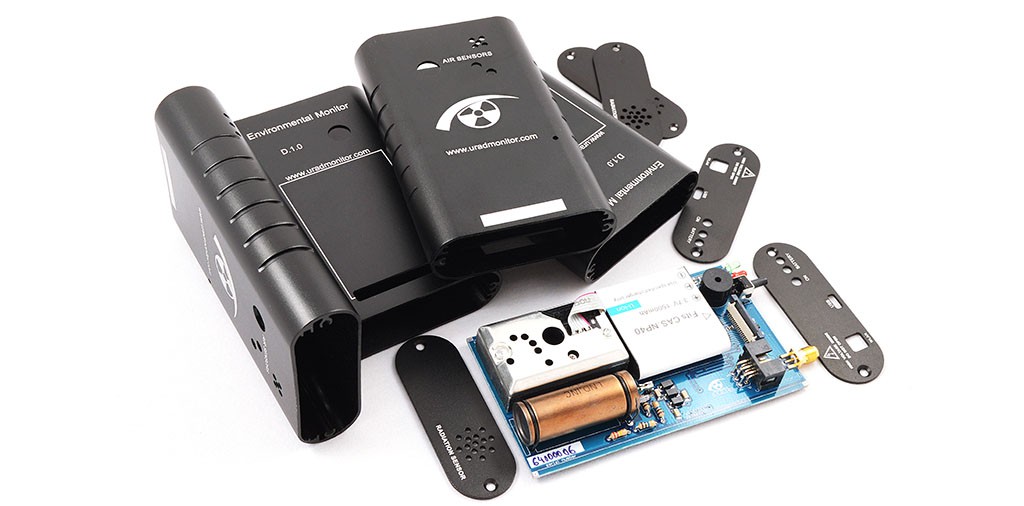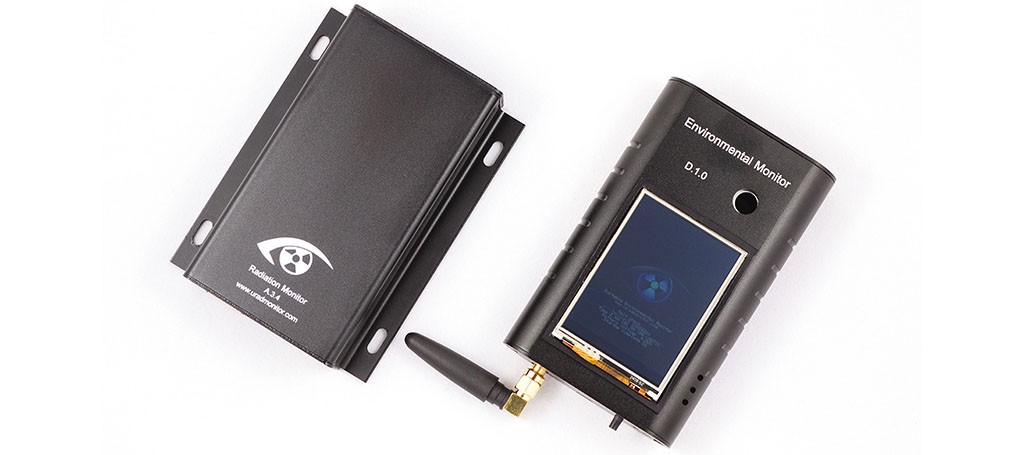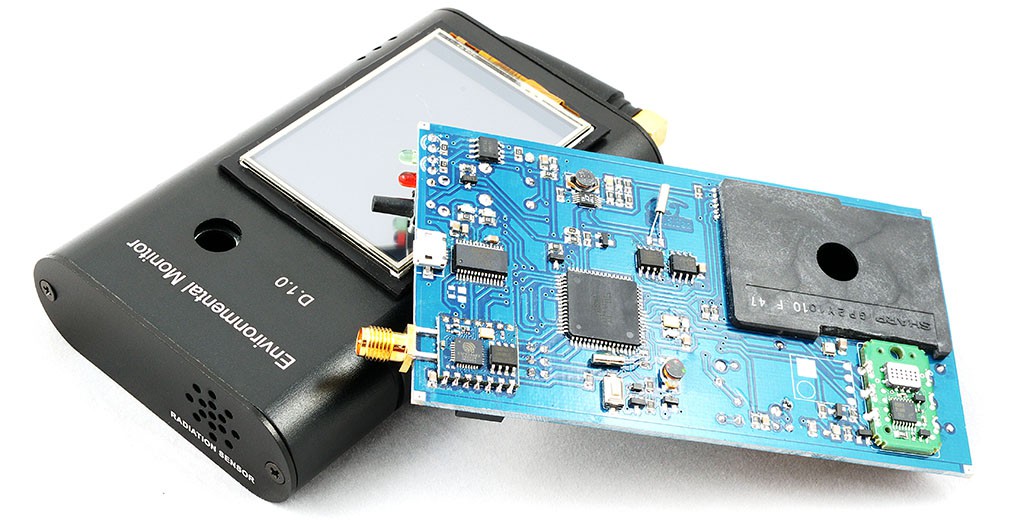-
Going for the feedback
07/10/2017 at 21:01 • 0 commentsCommitted to the Hackaday Prize 2015 recognition and the IndieGogo crowdfunding campaign, the long uRADMonitor D development was pushed continuously until reaching its goals. Some on the ups and downs here.
Finally, the first model D units have started to ship. I created a dedicated thread on the forum to try to learn what the model D users think. It goes both ways, I get the feedback and learn what needs to be improved, while they get the most out of their new gadget. Should there be model D users among the HaD users, you're all invited!I got used to my own model D unit , taking it everywhere. Here's a picture while I visited Alba Iulia, one of the first #smartcities that embraced the uRADMonitor technology
Of course that going underground, in the Turda salt mine resulted in a healthy air and radiation readings close to 0 thanks to the excellent cosmic radiation shielding:
As it happened with the other hardware units comprising this big project, constant work is being put into constantly improving the software. This is one of the great things in current electronics: you make the design, and then you improve the software, making the most out of it.While I'm here, I should add that Hackaday played a big role in this entire story. The exposure I got after the Hackaday Prize 2015 helped with developing the new directions, including the new uRADMonitor A3 device that is now being used to monitor 4 cities. Thank you! -
Finally there!
05/10/2017 at 19:12 • 0 commentsBack in 2015 when this all started, the complexity of this work was acknowledged and the project was one of the 10 finalists in the Hackaday Prize 2015 and also a BestProduct finalist. The year comes back to my mind with so many beautiful memories. By the time I was working on this project, it was the hot summer of 2015, my daughter was a few months old and while learning to be a dad I was also investing energy into making this project happen. Life unfolding itself right before my eyes, with only determined will to guide its outcome. Then thanks to @Sophi Kravitz and the other amazing people at Hackaday I had the chance to be a speaker at the #Hackaday SuperConference 2015.
My message there was about the need to move from a hobby to something that actually has a purpose. This is an issue with makers in general, as most of us love to start many things, and finalise none.
Personally, I am a very determined person. My final goal goes beyond the little things, and probably this works as the perfect motivation. Some on that here.The "Portable Environmental Monitor" didn't win any of the fabulous prizes of the competition, yet this didn't stop me from finalising it. It took a lot of time as it's 2017 already, I had to find the resources for what it became a highly complex project, while keeping my startup company going. With enough will , the work finally came to a result.
The Hackaday Prize helped a lot! The feedback of the jury, expressed publicly, boosted the exposure to Mars and back. Here's Dave Jones' mailbag:
Then Ben Krasnow & Pete Dokter as part of the Hackaday Prize 2015 Jury feedback:
The amazing HaD people which I was delighted to meet in person, after their amazing articles on my previous work:
http://hackaday.com/2012/03/09/a-capacitive-discharge-weldercutter-for-all-your-lightweight-needs/
http://hackaday.com/2014/09/11/global-radiation-monitoring-network-update/
http://hackaday.com/2012/12/07/online-radiation-monitoring-station/
http://hackaday.com/2015/07/18/hackaday-prize-entry-a-portable-environmental-monitor/
http://hackaday.com/2015/11/07/air-quality-surveillance-for-whole-cities/
Mike, Brian, Adam, and all the rest, thanks for your support over all this time.
People at Atmel and Bosch were also supportive during all this time.
You made things so much better and I am grateful.
But, this is a project log, so let me show you the other technical details that kept me busy.
1.Hardware updates
Following the successful indieGogo campaign I was telling you in the previous log, the promised stretch goals were added to the design. This included a slot for an SDCARD to save huge amounts of data offline, a GPS module to map location and a RTC IC. As a result, there were 5 revisions of the PCB, see them here:
 The Wifi antenna was changed to an internal, ceramic one, and it was interesting to find solutions on getting the RF field out of the aluminium enclosure. With some carefully designed openings, this became possible. If you read the comments section below, you'll see this feature was initially requested by Ben, and I loved the idea as it makes the design more compact.
The Wifi antenna was changed to an internal, ceramic one, and it was interesting to find solutions on getting the RF field out of the aluminium enclosure. With some carefully designed openings, this became possible. If you read the comments section below, you'll see this feature was initially requested by Ben, and I loved the idea as it makes the design more compact.2.Software
Hardware needs software. From about 3000 lines of firmware code at the end of 2015, the firmware got up to about 9000. The rushed code written before the Hackaday Prize challenges was properly rewritten, so it would handle sensor readings, an UI, user touch readings and data synchronisation over the Internet. All this on an 8bit microcontroller, upgraded from Atmega128 to the better Atmega2561.
 To configure the Wifi settings, I implemented a software keyboard. Reminded me of the good old embedded development years on Windows Mobile.
To configure the Wifi settings, I implemented a software keyboard. Reminded me of the good old embedded development years on Windows Mobile.3. The server frontend
Don't forget this work is linked to the bigger uRADMonitor project, where several IOT devices are used to do measurements and centralise all data online. As the #Portable environmental monitor is a mobile unit, support for mobile units had to be added. This happened nicely, in a good moment, coming to complement the already existing #uRADMonitor A3 units installed in public transportation in the first Romanian smart city, Alba Iulia.
More on this in a blog post, here.
4. The dashboard
Unit manangement was added , so unit users have control over their hardware. The section for that was called the Dashboard:
5.The plastic bezel
Back to hardware, but not electronics, a plastic bezel had to be manufactured to hold the LCD in place. Then , after the GPS addon, a new plastic cover for the antenna was needed. Design for this went smoothly,
To serve the first production batch, a limited quantity had to be ordered, so making a mold was not an option. What I did was to find alternatives:
- Resin 3D printing on an iSLA-650 PRO was tempting, but there was no Black colour, and painting the parts would not solve the problem, as with wear the white below the paint would become visible.
- Black ABS injection in Silicon molds. This comes with a reasonable cost for the quantity, and the base plastic is black, matching the anodised aluminium body. It also allows for nice details on the parts. This solution was selected, and here are the few prototypes the factory made to check the parts:
 It took a lot of work to get things here. There were times I felt the pressure of this project, seeming impossible to complete. I knew I had to keep moving. Finally, the work is done , and a new IOT gadget is available on the market, impacting pollution and the quality of life, with measurements from all around the work, making the invisible harmful factors, visible.
It took a lot of work to get things here. There were times I felt the pressure of this project, seeming impossible to complete. I knew I had to keep moving. Finally, the work is done , and a new IOT gadget is available on the market, impacting pollution and the quality of life, with measurements from all around the work, making the invisible harmful factors, visible. Now that this project is done, I'll finally be able to move on, to other exciting preocuupations.
Read more on the uRADMonitor network here.
-
Adding the SDCard
03/11/2016 at 15:17 • 8 commentsAs a result of the previous indieGogo campaign, we not only got the funding but also a few stretch goals. One was adding SDCard support to the uRADMonitor D, and can tell you - this wasn't easy. First it involved redesigning the PCB and making enough space for the card slot. Then it was the software: spi communication, card physical layer then the file allocation table implementation.
Finally, after many tests, we have the basic card functionality up and running. The pictures shows one of the latest uRADMonitor D iterations, using a 16GB SDCard.
Now how much data will we be able to hold on those? Easy answer: all of it :)
-
Model D updates
12/13/2015 at 20:15 • 0 commentsSome of the remaining changes for uRADMonitor model D included finalising the firmware and identifying a few better alternatives for the LCD bezel. Should the indieGogo campaign reach it’s stretch goal, we’ll also see a GPS module added to this unit, and an internal antenna for a more compact design.
But getting back to the firmware, one important achievement was increasing the display speed:
A less bulky LCD bezel had to be designed, but this wasn’t an easy process, since several iterations had to be tried out, and the printer pushed to its limits with thin plastic layers:

Finally the results, making model D take maximum advantage of this new iteration:
More work is required on the firmware side, so make sure to follow our progress to see what we bring next. -
THE HACKADAY PRIZE 2015
11/20/2015 at 20:36 • 0 commentsThe uRADMonitor model D, or the Portable Environmental Monitor, has entered this year’s Hackaday Prize competition, throwing in a complex hardware design, backed by a matching software infrastructure implemented with thousands of lines of code. What started with a simple hand drawn diagram was followed later by the Beta prototype and finally led to the production unit but not without a very intense creative process, done under a lot of pressure:

The uRADMonitor is a global network of interconnected hardware devices that work as detectors for various chemical or physical pollutants impacting human health. The current detectors can measure air temperature, barometric pressure, humidity, dust concentration, VOC but also Alpha, Beta and Gamma radiation. The latest uRADMonitor model D, uses the BME680 sensor from Bosch to assert air quality. This is an ambitious project that didn’t get intimidated by the difficulty of a global scale solution implementation. In the end, there’s an important goal that keeps it in motion, and that goal is to improve the life of all people on Earth, by increasing the quality of our environment, in homes, work offices or whole cities.
The winners of the 2015 prize awards were to be announced at the Hackaday Superconference which was held in San Francisco, last weekend. I got there on Friday, after a long flight from Budapest. It was absolutelly thrilling to meet all the great people behind the Hackaday articles. I remembered the excitement of having my first project featured on their website. Surely I didn’t forget to take photos with everyone and I also made new friends among the fine people attending the conference, which was a successful event:
The motivation to take part in the Hackaday Prize was to solve a problem a large number of people is facing. uRADMonitor helps by identifying pollution with its array of network connected detectors spread all across the Globe. But to achieve that, progress had to be made to add more features to the new hardware units: portability in terms of a rechargeable lithium battery, a power management system to charge the battery but also invert its voltage to system needs, a separate 500 volt inverter for the Geiger tube, a dust sensor, a Geiger tube and air quality sensors all packed in so little space, wireless connectivity successfully talking with the central server in real time, which required a predefined protocol and more complexity on the software side since it also includes encryption for data security, and finally drivers and real time functionality in software to handle the sensors with good accuracy. All this, almost doubled by server side software, handling big data on the back end, and dynamic charts on the front end, to deliver informative environmental updates for a real time user experience, despite the complexity of the entire system.
The challenges were endless, given the ambitious size of this project: research in sensor physics, design hardware units from scratch, put them into production, develop a robust firmware code (3000 lines of code and counting), configure and develop server side software, capable of supporting big data. Seeing this list of words I can’t believe how simple it sounds, remembering all the challenges along the road: for instance, to meet the Best Product deadline of the Hackaday Competition, I was still uploading code on the three demo units to be shipped, while the shipping company was already knocking on my door, to pickup the package, all this after a few sleepless nights. Also various hidden bugs, both in hardware and software, part of any development process and these were also time consuming. Speaking about time that is a total of almost half a year of continuous work and even more of background research. This came at a cost which sometimes I find too big: working continuously instead of having walks with my daughter and wife, going to sleep only to wake up working again in the morning, not seeing summer’s warm sun as by the time the project was complete it was almost winter. But there is a cost to pay for each endeavour.
A very long chapter is ending, all is now fixed and developed properly, and the final product is finally here, not only ready for production including enclosure design, pcb and assembly, testing, accessories, packaging and shipping, but already deployed worldwide. For a one man, this was a lot to do.
The Hackaday Prize was a fierce competition and uRADMonitor was among the few titles that already had a presence on the market, proving its matureness as an additional one step further over the already complex hardware and software, an important thing in developing a “best product”, an attribute that uRADMonitor project earned not by a title or prize, but the hard way. -
Bosch BME680
10/29/2015 at 23:43 • 0 comments The BME680 is an integrated environmental sensor developed specifically for mobile applications and wearables, where size and low power consumption are key requirements (source). While not yet available on the market, several BME680 samples have been provided under NDA to assist the development of the uRADMonitor-D project and support the monitor’s air quality assertion. The part of the uRADMonitor-D code handling this new sensor is currently under development , but the first tests have shown promising results:
The BME680 is an integrated environmental sensor developed specifically for mobile applications and wearables, where size and low power consumption are key requirements (source). While not yet available on the market, several BME680 samples have been provided under NDA to assist the development of the uRADMonitor-D project and support the monitor’s air quality assertion. The part of the uRADMonitor-D code handling this new sensor is currently under development , but the first tests have shown promising results:The gas sensor within the BME680 can detect a broad range of gases to measure indoor air quality for personal well being. Gases that can be detected by the BME680 include: Volatile Organic Compounds (VOC) from paints (such as formaldehyde), lacquers, paint strippers, cleaning supplies, furnishings, office equipment, glues, adhesives and alcohol.
The humidity sensor features a best-in-class response time supporting performance requirements for emerging applications such as context awareness, and high accuracy over a wide temperature range.
The pressure sensor is an absolute barometric pres- sure sensor featuring exceptionally high accuracy and resolution at very low noise.
The integrated temperature sensor has been optimized for very low noise and high resolution. It is primarily used for temperature compensation of the gas, pressure and humidity sensors, and can also be used for estima- ting ambient temperature.The BME680 comes fully calibrated for all sensor components. Its impressive features make it a great addition to the uRADMonitor-D line of products to improve the performance of the portable environmental monitors even further.
-
First prize at West Romania's regional Innovation Fair
10/21/2015 at 21:55 • 3 commentsThe Regional Innovation Fair 2015 aims to promote innovative technologies and solutions and brings together business and research professionals allowing you to open new business channels, exchange contacts and discuss potential cooperation in West Region, Romania. uRADMonitor is honoured to take the first prize, and is committed to continue delivering monitoring solutions, to track pollutions and help improve the quality of our environment.


 Thank you to the judges for giving us their vote and trust and to ADR Vest, Tehimpuls Timisoara, Innovation Norway and UniCredit Bank for making this event possible.
Thank you to the judges for giving us their vote and trust and to ADR Vest, Tehimpuls Timisoara, Innovation Norway and UniCredit Bank for making this event possible. -
Pollution Monitor meets 3D Printing
10/10/2015 at 10:47 • 1 commentThe portable environmental monitor is finalist in both categories of the Hackaday Project, Best Product and the GrandPrize but the development doesn’t stop here. We’ve managed to put together a complex piece of equipment that also has an appealing design. One thing missing was a proper bezel to protect the LCD and to hide the bottom connector. A custom 3D-printed component by Ovidiu, the designer of Lighty, did the trick and now uRadMonitor looks more professional than ever.
More pictures are available on the uRADMonitor FB page The plastic component was first designed in 3D, very much like with the rugged aluminium enclosures. And for part itself, a full metal Delta printer did the rest:
The plastic component was first designed in 3D, very much like with the rugged aluminium enclosures. And for part itself, a full metal Delta printer did the rest:
-
uRADMonitor featured on Digi24 TV
09/26/2015 at 20:44 • 0 commentsThe portable environmental monitor fights to solve one of mankind’s greatest problem: pollution. As it tries to improve the life of a large number of people, the uRADMonitor-D was featured on TV, and so the Hackaday project was broadcasted to the national audience in Romania.
Air pollution, particularly matter that goes unseen by the human eye, ranks high among the leading causes of chronic illnesses and terminal diseases (source). The Portable Environmental Monitor (uRADMonitor-D) can increase our awareness and help us with our pollution detection capabilities.
With its sensor array and the capabilities to map the measurements to geographic areas, it has the potential to offer an easy overview of the more affected areas, so action can be taken. Read more on the uRADMonitor model D here.
-
Production Ready!
09/19/2015 at 12:01 • 0 commentsThe portable environmental monitor addresses pollution, the kind that we are unable to see but directly affects our health and can cause life threatening diseases. Airborne toxic chemicals, radioactive dust and radioactive radon are correlated with cases of pulmonary cancer, asthma and heart disease. Since our biological senses can do little to warn us of such possible dangers, we have designed the Portable environmental monitor as a first line detection and warning system. This is not the regular detector: packed with powerful sensors capable of detecting both the chemical and the physical harmful factors, these devices are designed with Internet wireless connectivity to share all readings to the Global uRADMonitor network.
September 2014, almost one year ago, the “production ready” of the Model A series of radiation detectors was announced. Interest was excellent and as a result the uRADMonitor network got were it is today, continuously committed to offering open environmental surveillance data. There was also generous feedback from the community, helping to understand how to shape the next steps better. And some of that we see today, embedded in the new uRADMonitor-D units. Features like built in WiFi connectivity, rechargeable battery, LCD display were all highly wanted. But hardware is just half the story as the many software layers also come to complement the solution, a recent example being the network’s webportal, updated to support all the new features. The many improvements also include a high quality LND 712 Geiger tube, perfect for detecting alpha, beta and gamma radiation. The new uRADMonitor-D monitors not only ionising radiation, but also air quality to address pollution at a global scale. The new units are portable, meaning they are well suited for field use. There’s a huge 2.4″ color LCD with touchscreen for all user interactions. The wireless connectivity and the built in flash storage can be used to synchronise the readings with the server, when wireless Internet is available. There’s been a long road getting from there to here, and this was possible only thanks to the interest and support manifested by the entire community. This was after all, a crowd project built to serve the interest of us all.
The many improvements also include a high quality LND 712 Geiger tube, perfect for detecting alpha, beta and gamma radiation. The new uRADMonitor-D monitors not only ionising radiation, but also air quality to address pollution at a global scale. The new units are portable, meaning they are well suited for field use. There’s a huge 2.4″ color LCD with touchscreen for all user interactions. The wireless connectivity and the built in flash storage can be used to synchronise the readings with the server, when wireless Internet is available. There’s been a long road getting from there to here, and this was possible only thanks to the interest and support manifested by the entire community. This was after all, a crowd project built to serve the interest of us all.
Getting a unit Putting the numbers in the hands of people will directly impact pollution awareness, leading to a more rational attitude in regards to the environment – and as a direct result – improved quality of life. uRADMonitor is just a tiny component of the big plan to get us there.
Putting the numbers in the hands of people will directly impact pollution awareness, leading to a more rational attitude in regards to the environment – and as a direct result – improved quality of life. uRADMonitor is just a tiny component of the big plan to get us there.To get a uRADMonitor device and join the network, see Join the network or build your own, as uRADMonitor-D is 100% open source and fully documented on Hackaday.io. More hi-res photos of the model D production units are available on the FB page or on Hackaday.io.
[top Air Pollution image credit: http://www.bloodflowonline.com/perspectives/air-pollution-and-cardiovascular-diseases]
Portable environmental monitor
A handheld, battery powered, sensor array unit for environmental monitoring focused mostly on air quality using a global infrastructure.
 Radu Motisan
Radu Motisan